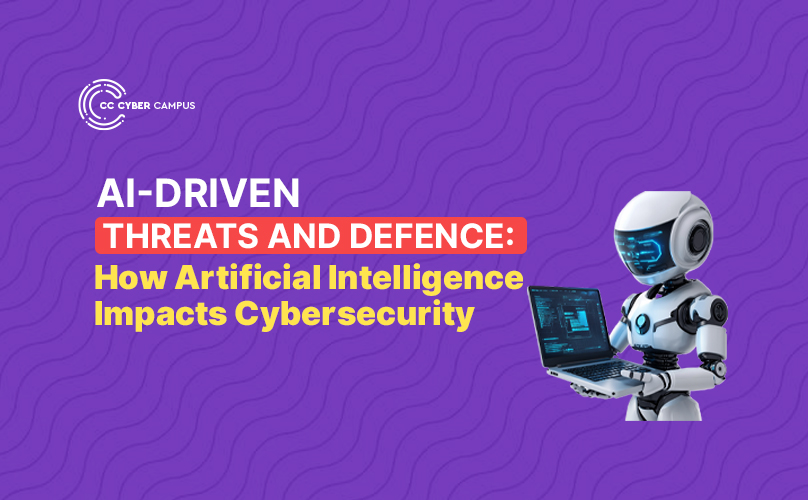
Digital Marketing
At CC CyberCampus, we...


What Is AI in Cybersecurity?
Understanding AI-Driven Threats
Common Examples of AI-Driven Threats
The Role of AI and Generative AI in Cyberattacks
How AI Strengthens Cyber Defence
How Defence Teams Use AI and ML
Benefits of AI in Cybersecurity
Challenges and Risks of Using AI
Governance of Shadow AI in Organisations
The Future of AI in Cybersecurity
Why Learning AI and Cybersecurity Matters
Artificial Intelligence (AI) is transforming cybersecurity, both for good and bad. While AI helps detect and prevent attacks faster, it also powers new and complex threats. This blog explains in simple words how AI-driven threats and defences work, their impact and why understanding them is key for cybersecurity professionals.
Artificial Intelligence (AI) in cybersecurity means using smart computer systems that can learn from data, detect patterns and make quick decisions to protect networks and devices. Instead of waiting for human action, AI tools can automatically spot and stop threats, keeping systems safer and faster than traditional methods.
AI-driven threats are cyberattacks that use artificial intelligence to become smarter and harder to detect. Hackers now use AI to automate attacks, create fake content, or find weaknesses in systems. These attacks can spread faster and adapt to security changes, making them more dangerous than ever before.
Here are a few ways AI is used for harmful purposes:
These examples show how attackers are using AI’s intelligence for harmful goals.
Generative AI is making cyberattacks even more advanced. Hackers can now use AI tools to automatically create malware, phishing messages and deepfake content at scale.
Just as hackers use AI to attack, cybersecurity experts use AI to defend.
AI-based security tools can:
AI helps security teams save time and focus on serious risks instead of routine alerts.
Defence teams use AI and Machine Learning (ML) to strengthen their ability to detect and respond to threats more efficiently.
According to Gartner, a leading global research and advisory firm in technology and cybersecurity, modern cybersecurity systems now use AI/ML to:
This combination of AI and ML helps defenders act faster and smarter than traditional manual systems
AI makes cybersecurity stronger, smarter and more proactive.
Even though AI helps, it also brings challenges:
That’s why balance between automation and human expertise is very important.
A growing concern in cybersecurity today is “Shadow AI”, when employees or departments use AI tools without official approval or security checks. This unauthorised use of AI can lead to data leaks, compliance violations and serious cyber risks.
Strong AI governance policies and clear usage guidelines are essential to prevent shadow AI from becoming a hidden vulnerability inside organisations.
In the future, AI will play an even bigger role in protecting digital systems. We’ll see smarter algorithms, faster responses and self-learning systems that can fight back automatically. However, cybersecurity experts must keep learning, because attackers will also use advanced AI tools.
Understanding AI-driven threats and defences is now a must for anyone in cybersecurity. With every new technology, risks grow and only trained professionals can stop them. Learning how AI works in cybersecurity helps you stay one step ahead of cybercriminals.
AI is changing cybersecurity forever. It gives us stronger defence tools, but also smarter threats. To stay safe in this fast-changing digital world, we must use AI wisely, combining smart technology with skilled professionals. Cybersecurity isn’t just about protection anymore, it’s about staying smarter than the attackers.